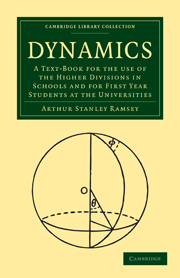 Dynamics
Dynamics Published online by Cambridge University Press: 07 September 2010
4·1. In the last chapter we discussed the measurement of the velocity and acceleration of a point moving in a straight line. We must now begin to study the branch of Dynamics called Kinetics, which is concerned with the effects of forces on the motion of bodies.
The definitions and laws of motion enunciated by Newton in the seventeenth century form the foundation of a science of dynamics which has been developed by many other mathematicians. This dynamics, now commonly called ‘Newtonian Mechanics,’ is the basis of all the theoretical work in applied mechanics or engineering and the results of the theory have been and are still being confirmed every day by numerous appeals to experiment; so that nowadays no one questions whether the theory is adequate to furnish reliable results in common matters. It is only when on the one hand we begin to investigate what is relatively very small, e.g. the interior of an atom, or on the other hand when we leave the Earth and apply the Newtonian theory on a much wider scale that discrepancies can be detected, and even here it may be remarked that Newtonian Mechanics has proved adequate to enable astronomers to predict the time of eclipses with an accuracy that would hardly have been possible had the foundations of dynamics been radically at fault.
From a philosophical standpoint Newton's definitions and laws of motion offer much scope for criticism, particularly his assumptions of absolute time and space.
To save this book to your Kindle, first ensure [email protected] is added to your Approved Personal Document E-mail List under your Personal Document Settings on the Manage Your Content and Devices page of your Amazon account. Then enter the ‘name’ part of your Kindle email address below. Find out more about saving to your Kindle.
Note you can select to save to either the @free.kindle.com or @kindle.com variations. ‘@free.kindle.com’ emails are free but can only be saved to your device when it is connected to wi-fi. ‘@kindle.com’ emails can be delivered even when you are not connected to wi-fi, but note that service fees apply.
Find out more about the Kindle Personal Document Service.
To save content items to your account, please confirm that you agree to abide by our usage policies. If this is the first time you use this feature, you will be asked to authorise Cambridge Core to connect with your account. Find out more about saving content to Dropbox.
To save content items to your account, please confirm that you agree to abide by our usage policies. If this is the first time you use this feature, you will be asked to authorise Cambridge Core to connect with your account. Find out more about saving content to Google Drive.